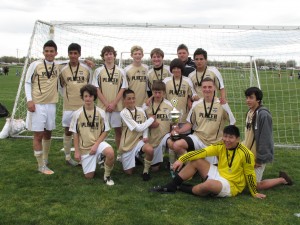Five Placer United girls teams saw great competition mid-March. The U16 girls black team played in their last event of the year at the Diablo FC Cup. The girls lost a tough opening match to the host, Diablo FC. The girls then rebounded and beat the CV Revolution 3-2 and the Sagebrush squad from Nevada 2-0. The girls missed the championship match by goal differential. Congratulations U16s on a great season!
The U15, U16, U17 and U18 girls gold teams travelled to Nevada to play in the prestigous Las Vegas College Showcase. There were over 250 college coaches in attendance for the event.
The U15 girls gold had 2 wins and 2 losses and were semi-finalists. They had a 2-0 win over Tucson Soccer Academy and a 1-0 win over Alliance FC. They fell to the Dakota Rev Rampage out of Minnesota, 2-1 and Harpeth from Tennessess 2-0.
The U16 girls gold had a very difficult draw as well. They had a 1-1 tie with Empire and a 2-0 loss to East Meadow out of New York. They then played the Chantill Firecats who are ranked in the top 5 nationally and lost 2-1 with numerous chances to tie the game late. They ended on a great note, beating the McClean Power 3-1.
The U17 girls gold won the championship in their division! They beat the Lady Renegades from Florida, 2-1, had two 0-0 tied games with Mass Premier from Boston and the Florida Rush. The girls also defeated Chicago Inter 7-0 as the girls put on a dominant performace.
The U18 girls gold tied with FC Milwaukee 1-1. They then had two 2-0 losses to Sparta from Utah and AUFC from New Mexico. In the most dominant performace of the weekend, the girls outshot Sereno Golden Eagles by a dozen and unfortunately gave up a goal against the run of play to lose 1-0.

